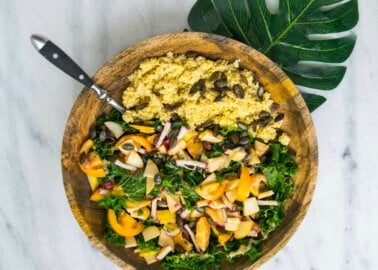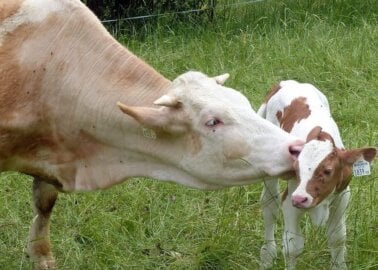This Is Why Honey Isn’t Vegan
There are more than 20,000 bee species around the world, but no matter their differences in size, location, and behaviour, they all have one thing in common: their populations are declining rapidly. Meanwhile, people are consuming more honey than ever before.
Since demand for bees’ honey and other “products” – like candles made from beeswax – remains high, these animals are intensively farmed, much as chickens, pigs, and cows are.

Here’s the not-so-sweet story of the way bees are exploited and killed for humans’ honey addiction.
Feeling the Sting of Factory Farming
As bees pollinate plants, they collect tiny drops of nectar to make honey. It provides them and their queen’s young with essential nourishment, especially while they hibernate.
But on commercial honey farms, they’ll never benefit from all their labour. In autumn – just as the bees are preparing to hunker down with their honey supplies for winter – beekeepers rob the hive. First, they smoke it, interfering with the colony’s pheromone signals and making it less organised so it’s hard for the bees to defend themselves. While removing the honeycombs, beekeepers typically wear a full-body suit, including a veil, for protection. If bees wanted humans anywhere near their honey, none of this would be necessary.

After beekeepers steal the honey, they feed the bees sugary syrup and other sub-par foods to keep them alive.
The stressful, unnatural living conditions, malnutrition, and cruelty inherent in factory farming weaken the bees’ immune systems. They become more susceptible to disease and less able to withstand the devastating impact of harmful pesticides.
It’s Not Easy Being Queen
When a new queen bee is about to hatch, a process called “swarming” occurs in which the old queen and half the colony leave the hive to set up a new one. During swarming, honey production usually drops, so many beekeepers try to prevent this. They either trap the queen inside the hive or “requeen” – killing the queen and replacing her with a younger version bought from a breeder. Most beekeepers requeen colonies every two years, but there is a growing trend towards annual requeening. If left alone, queens can live for as long as five years.
Queen bees are bred, sold, and shipped within the UK or imported from Europe and quarantined. In 2020, 21,000 queen bees were imported into Great Britain. It’s common for queen bees to be shipped in plastic boxes with around eight to 10 escorts, who are killed on arrival and examined for parasites. When shipped internationally, the queen begins to lay during transit and the importer keeps the larvae. The queen is never released from quarantine and is killed when the importer is finished with her.

And while it may be hard to imagine, artificial insemination is gaining popularity in the bee industry so that farmers can eliminate “undesirable” characteristics, such as the tendency to sting humans. This selective breeding is done to maximise profits, not for the welfare of the bees.
Inseminators gas a virgin queen bee with carbon dioxide to immobilise her. Then, they force her upside down into a small plastic container and hold her stinger with tweezers while inserting a needle or syringe with drone bee semen into her. Inseminators kill about 15 drone bees during the extraction process – they crush each bee’s head before milking him for his semen.
Bees and the Environment
Many beekeepers claim that farming bees and eating honey helps increase bee populations and, therefore, helps the environment, but that’s simply not true. It’s like saying raising chickens on factory farms somehow boosts wild bird populations. Honeybees are farmed to make money, and it’s wild species that are going extinct.
Bee populations are being decimated across the UK. Thirteen bee species have gone extinct since the 1900s, and 35 more are under threat of extinction. This is bad for us as well as for bees: approximately one out of every four mouthfuls of our food and drink is made possible by pollinators. But don’t buy into the lies. Honeybees aren’t as good at pollinating as bumblebees, carpenter and mining bees, and many other truly wild bee species. Honey is not a by-product of pollination – it’s a different business.

Because most species of native bees hibernate for as many as 11 months out of the year and don’t live in large colonies, they don’t produce massive amounts of honey. The little that they do produce isn’t worth the effort required to steal it from them. That’s why honeybees are farmed.
Honey is sold to make money, not to help bees.
The Complex Life of Bees
Bees have a unique and complex form of communication based on sight, motion, and scent that scientists and scholars are working to understand. Bees alert other members of their hive to food, new hive locations, and conditions within their hive (such as nectar supply) through intricate “dance” movements.
Studies have shown that bees are capable of abstract thinking, distinguishing their family members from other bees in the hive, using visual cues to map their travels, and finding a previously used food supply, even when their home has been moved. And similar to the way smells can invoke powerful memories in humans, they can trigger memories in bees, such as where the best food can be found.
What You Can Do to Help Bees
No animal, regardless of size, deserves to be exploited. Here are several ways we can all help bees:
- Let bees keep their honey. They need it for nourishment, but we don’t need it for flavouring. Use maple, golden, agave, or rice malt syrup instead.
- Let bees keep their beeswax – which they use to build honeycombs – too. Plenty of companies make great cosmetics and candles that don’t hurt bees – like K&R London.
- Plant a native bee–friendly garden with some lavender, grevillea, tea tree, bottlebrush, or honey myrtle. Check out this list of plants native bees love.
- Avoid using insecticides in your garden.
- Buy organic produce.



